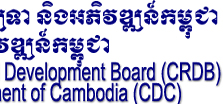 |
 |
 |
 |
||
|
|
|
MINUTES OF
THE SEVENTH MEETING 1. Mr. Chhieng Yanara, Chairman of the P&H TWG opened the meeting by welcoming participants to the seventh meeting of the P&H TWG. He proposed the following three agenda items for the meeting:
2. Before starting the firs agenda item, the Chair provided a general outline of responsibility of the P&H TWG. First, P&H TWG is the forum of discussion on policy, procedures, and practices on issues of harmonization, alignment and managing for development results for enhanced aid effectiveness under the ownership and leadership of the RGC. Second, P&H TWG is responsible for monitoring the implementation of RGC's Action Plan on Harmonization, Alignment and Results and, third, the dissemination of internationally agreed best practices and lessons learned in development cooperation management in Cambodia to all relevant Government institutions and development partners. On the other hand, the Lead Facilitator of this TWG has two important roles to play. The first role of the Lead Facilitators is to ensure effective coordination among donors to secure consensus position on issues under discussion on harmonization, alignment and managing for results for RGC consideration. The second is to undertake to provide six month report on progress made by each development partner on the implementation of H-A-R Action Plan. 3. Regarding the first agenda item, the Chair provided an update of the P&H TWG Action Plan for 2006. The plan was first prepared and presented at the last meeting of P&H TWG held on 7 February 2006. No comments were raised during the last meeting. P&H TWG Action Plan is organized by areas of priority based on the Terms of Reference of the TWG. Each area comprises activities that are being taken from the H-A-R Action Plan. He said that by the end of today's meeting when P&H TWG Action Plan for 2006 would be agreed, we also would discuss and agree on a mechanism for ensuring the implementation of activities in the P&H TWG Action Plan. 4. On the second agenda item, the Chair provided an update of the draft Declaration between RGC and Development Partners to implement Action Plan on Harmonization, Alignment and Results. The draft that was under discussion in this meeting has been revised based upon comments and suggestions made by development partners, and provided to the Chair through the coordination of UNDP in its role as Lead Facilitator of P&H TWG. The Chair said that the draft Declaration has incorporated to the greatest extent possible the comments and suggestions by development partners. 5. Regarding the first agenda item, the discussion was made according to the areas of P&H TWG's TOR and the corresponding needed activities. Specifically concerning mechanism that must be in place to follow up the implementation of P&H TWG Action Plan, the Chair pointed out one important activity in the P&H TWG Action Plan: responsibility to produce a six month progress report on the implementation of RGC's H-A-R Action Plan. He said that a mechanism to collect information on this activity is very important so that CDC/CRDB could prepare a comprehensive progress report on H-A-R Action Plan. During the discussion, there were concerns raised about the growing number of reports and reporting that are being expected from development partners. JICA pointed out that if development partners were required to report on progress against H-A-R Action Plan, it would be such a burden especially for JICA that needs to cope with its limited resources. 6. In response, the Chair emphasized that comprehensive information is needed to prepare the six month progress report, and that there is no intention at all to create a new mechanism for this purpose. This effort should maximize using existing structure to collect information in this area. He gave one suggestion that if the Chair of TWGs and Lead Facilitators work closely to produce a comprehensive report on progress against H-A-R Action Plan in their respective area, this would be very helpful. Because of complexity involved, members of P&H TWG agreed to set up a small group to deal with the task. The sub group is mandated to produce a concept paper on what the six month progress report should look like, and what is the appropriate mechanism to collect information to prepare the report. Sub group is scheduled to complete its task by the next two weeks (by the GDCC meeting on 14 June 2006). 7. On activity "Development partners review their country assistance strategies to align their assistance with NSDP priorities and sector development plans" it was agreed the timing for this is changed from "June 2006" to "on-going." Regarding the two activities related to PIU/PMUs, clarification was sought from the Chair on strategy and agreement to secure that no new parallel PIU/PMU will be established for new projects/programs. In response, the Chair said that the H-A-R Action Plan stipulates that no new parallel PIUs/PMUs will be established for new projects/programs, and that based on this agreement, strategy to phase out the parallel ones will be formulated and agreed with development partners after the OECD/DAC questionnaire on monitoring the Paris Declaration is finished, as by then the number of existing PIUs/PMUs in Cambodia will be known and used as a baseline. Comments were also provided on activity "CDC/CRDB and development partners jointly set targets on the portion of ODA that is to be delivered through sector/thematic programs, and other program based approaches to be reached by 2010 in the framework of NSDP, and develop and maintain a strategy to reach the agreed targets." It was suggested that effort should be made to understand what the obstacles that are being experienced at the sector level by TWGs, and that could affect the move toward using sector approach or program based approach. The Chair also indicated that it is the intention and objective of the RGC to increase the portion of ODA using sector/program based approach. In the last OECD survey, development partners reported that about 15% of ODA were being channeled through a sector/program based approach. Once the 2006 OECD/DAC survey has been completed, more will be known whether this proportion has increased or decreased. 8. Regarding the second agenda item on the draft Declaration between RGC and Development Partners to Implement the Action Plan on Harmonization, Alignment and Results, the EC pointed out that the draft Declaration does not contain any indicator. The Chair explained that now both the Government and development partner are completing the OECD/DAC survey. The outputs from the survey will provide a baseline for Cambodia. By the end of 2006, the Action Plan on Harmonization, Alignment and Results will be reviewed to incorporate monitorable indicators. As a sum up for this second agenda item, the Lead Facilitator indicated that most of the comments and suggestions on the draft Declaration have already been incorporated into the document. 9. On the last agenda item, the Chair said that he would like to share information with the group on several issues. First, the review of the effectiveness of GDCC/TWG mechanism is being carried out under the umbrella of the GDCC Secretariat. The views, comments and suggestions from government institutions and development partners are critically needed. Once it has been completed, the review will be submitted to the Government for consideration. The second information that the Chair would like to share with the group is that CDC/CRDB, with support of the Multi Donor Support Program for Aid Coordination, has identified a new incumbent to succeed Dr. Farid Siddiqui who has worked as Senior Adviser to CDC/CRDB for more than four years. The Chair said that the support and services provided by Dr. Farid Siddiqui are highly appreciated. The third issue is about completing the OECD/DAC questionnaire. To provide an update, Ms. Helen Appleton, as a Lead Facilitator of the P&H TWG, gave a brief presentation on the status of the work that is being carried out. 10. The Chair also informed the group of the Development Cooperation Report questionnaire for 2006. The DCR questionnaire has been revised to provide more clarity regarding the following points: implementing agency of the program/project whether it is government institution or non government institution; whether the program/project is part of a broad sector program; government contribution to the program/project whether it can be monetized to contribute to the preparation of next year PIP; issue of double counting; distinction between various components of a Technical Cooperation project; and sector classification according to that in the NSDP. Some indicators of the Paris Declaration have been incorporated in the revised draft as well. He added this DCR questionnaire is not final yet and will be sent out to all development partners for comments and suggestions. The DCR survey will be conducted in early 2007. 11. The meeting adjourned at 11:30 am.
List of Participants
|